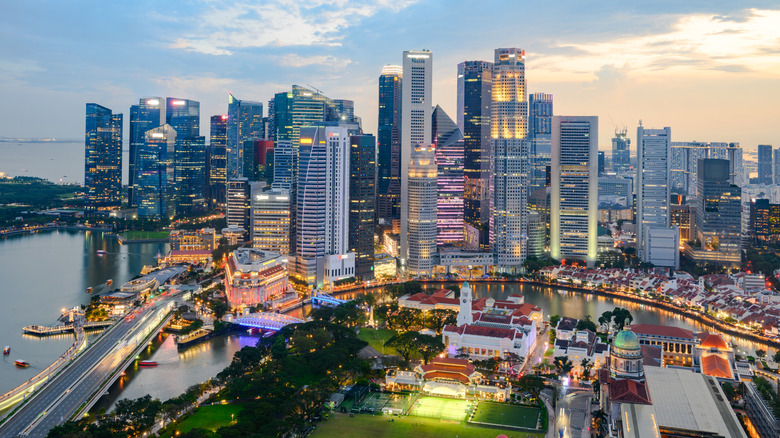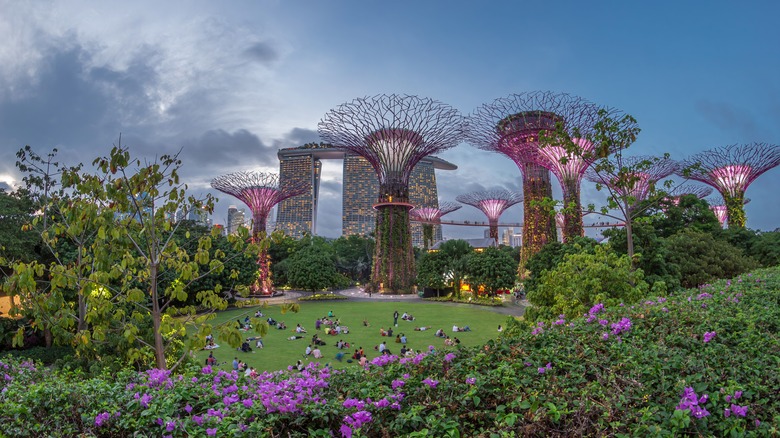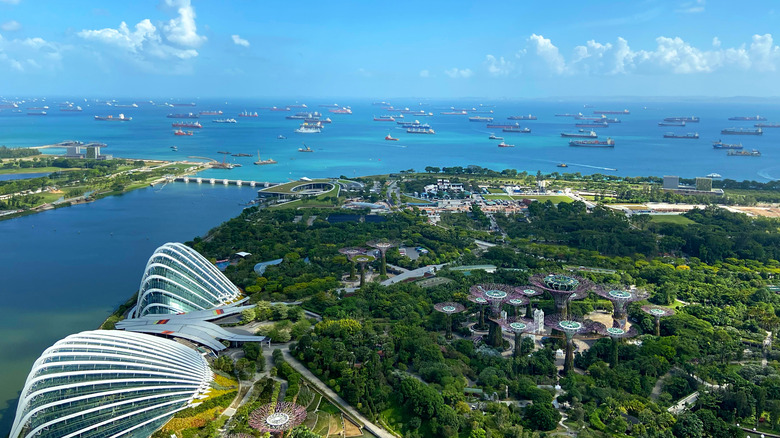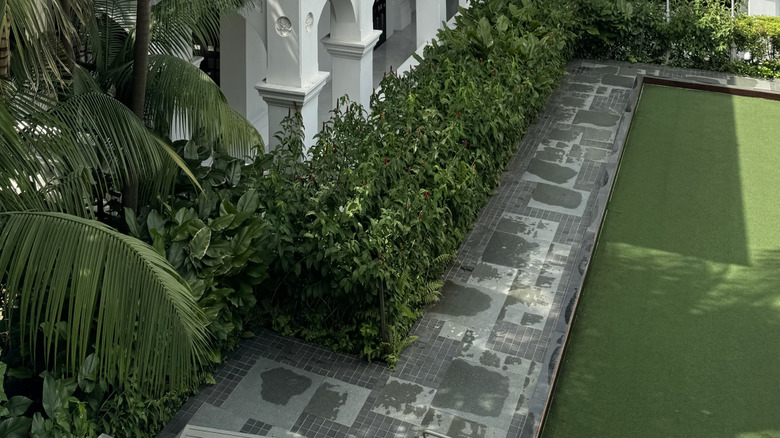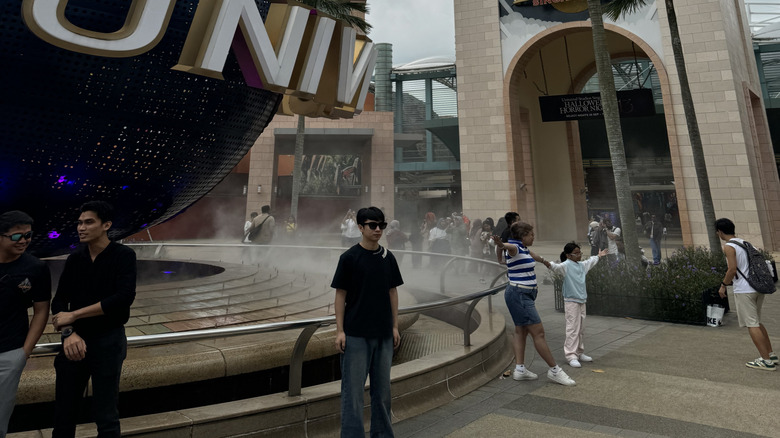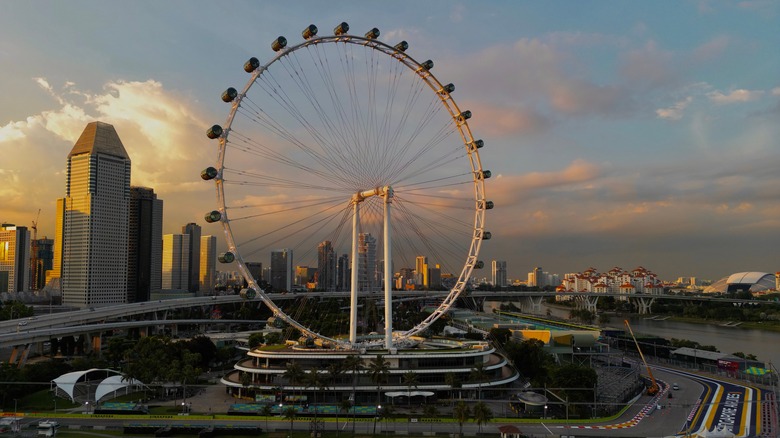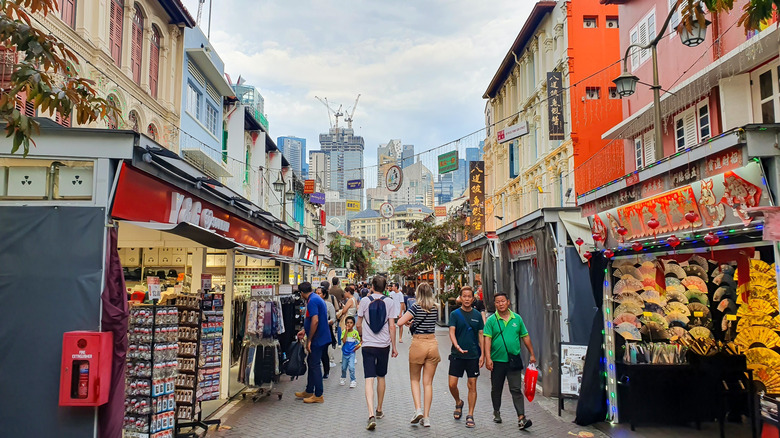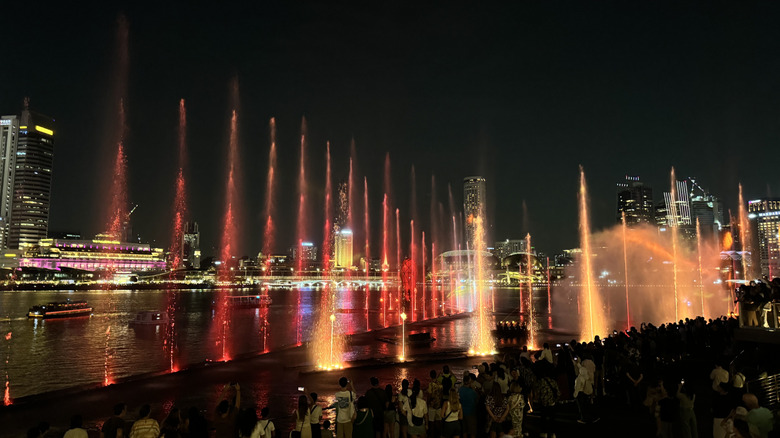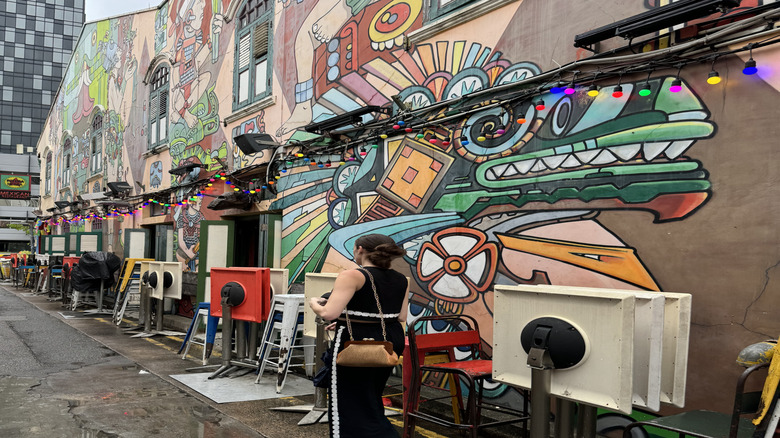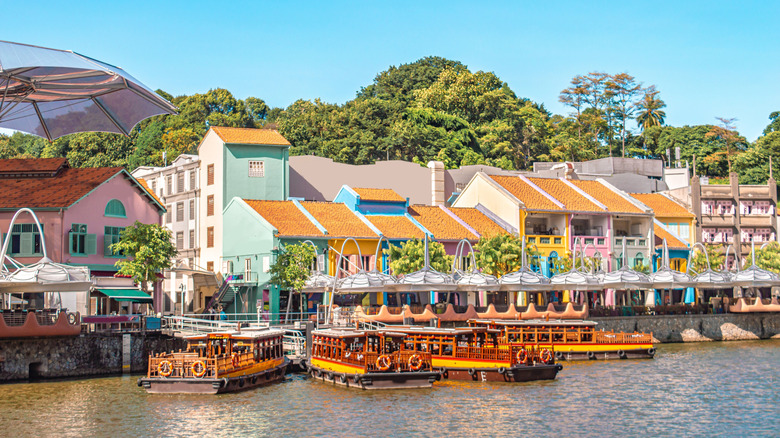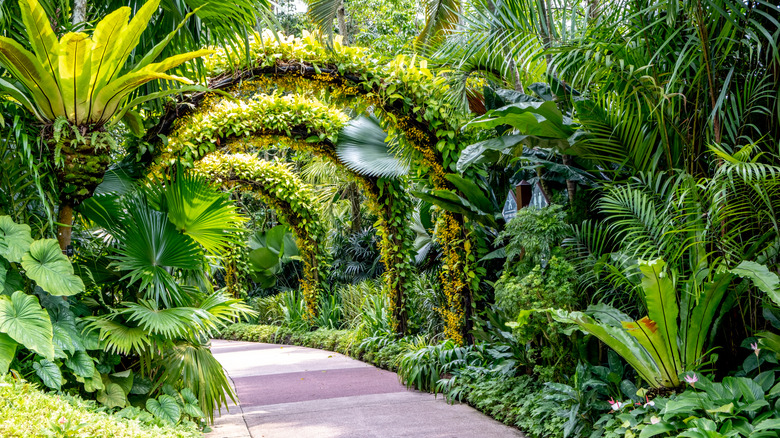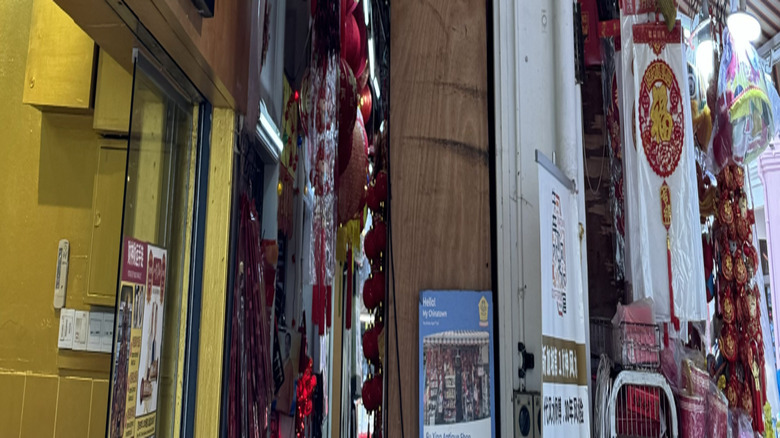Singapore's 10 Must-See Tourist Attractions For Your First Visit
I recently returned stateside from a five-day trip to Singapore, part of a longer journey through Southeast Asia, and it exceeded my expectations. Sleek and endlessly surprising, Singapore feels like you've stumbled on the Las Vegas of the East. With its swanky architecture, high-end shopping, and nightly water and light shows that rival the Bellagio fountains, the city is nothing short of dazzling. But beneath the glitz and glam lies a cultural blend of Chinese, Malay, Indian, and Western influences that make for a one-of-a-kind travel experience. Whether you stick to more well-known areas like Kampong Glam or venture to generations-old underrated neighborhoods like Katang Joo Chiat, you'll be sure to fall in love.
Home to one of the world's most powerful passports, Singapore may only cover about 280 square miles, but it's brimming with things to do. In a single day, you can savor UNESCO-approved street food, visit a centuries-old temple, shop the world's best designers on Orchard Road, and watch a nighttime spectacular. Even more impressive is the city's commitment to cleanliness and the hospitality of locals, which you'll find at every turn.
In this guide, we'll take a look at 10 must-see attractions for first-time visitors to Singapore that you absolutely can't miss. No matter what initially draws you to this city-state, there's no doubt it will beckon you back after your first trip comes to an end.
Gardens by the Bay
Gardens by the Bay is one of Singapore's most popular attractions. In fact, it's even been voted the No. 1 thing to do in the country. If you've vaguely researched your upcoming trip, you've probably seen pictures of the futuristic Supertree Grove with its iron trees extending 160-plus feet into the air. To get a bird's eye view of this nature park and the nearby Marina Bay, guests can walk along the 419-foot-long OCBC Skyway — an elevated path suspended between the trees. While the Skyway has an additional fee and is only open between 9 a.m. and 9 p.m., the Supertree Grove itself offers free daily entry from 5 a.m. to 2 a.m.
That said, to fully experience Gardens by the Bay, we recommend purchasing tickets to the Flower Dome, Floral Fantasy, and the Cloud Forest. The Flower Dome is the world's largest greenhouse, housing everything from Mediterranean blooms to African Baobab trees. Meanwhile, a visit to Floral Fantasy offers an explosion of color, with curated bouquets and flower arrangements. Finally, the Cloud Forest, modeled after a high-altitude rainforest, features plant life that is normally only found about 2,000 feet above sea level. The Venus flytraps and a 114-foot-tall indoor waterfall are two highlights. Once the sun sets, the Garden Rhapsody light and sound show turns the Supertree Grove into a nighttime spectacular. Happening daily at 7:45 p.m. and 8:45 p.m., the theme of the show varies by date.
Marina Bay Sands SkyPark Observation Deck
One of the best things to do when you arrive in Singapore is get the lay of the land from the Marina Bay Sands SkyPark Observation Deck. At 56 stories up, travelers can see Singapore's entire cityscape — from the Gardens by the Bay to the Singapore Flyer, and the yachts and cargo ships in Marina Bay. We found this to be the perfect spot to orient ourselves before we began our adventures on the ground.
Beyond the views, the observation deck is also architecturally stunning. Designed to look like a boat, it is 1,115 feet long, which is approximately the length of four American football fields. Part of the Marina Bay Sands complex — which includes the SkyPark, hotel, and casino — it opened in 2010 and has been delighting visitors ever since.
But there's much more to the Observation Deck than just taking in the 360-degree views. The Sunset in the Sky package allows travelers to enjoy a romantic, golden hour evening on top of the world. This ticket includes priority entry and seating, Wolfgang Puck chocolates, a glass of champagne (alcoholic or non-alcoholic), and a custom photo album. Alternatively, another way to experience nightlife at the SkyPark is to attend the once-a-month Silent Disco, which features three DJs spinning tunes streamed to concertgoers via headphones. If you want to purchase standard daytime tickets, you can do so at the gate or online in advance.
Raffles Hotel
Nowhere captures Singapore's colonial history as elegantly as Raffles Hotel. Built in 1831 as a private residence and converted to a hotel in 1887, this grand icon has hosted the world's elite for over 100 years. From Ava Gardner and Charlie Chaplin to literary giants like Rudyard Kipling and Somerset Maugham — who once declared that "Raffles Hotel stands for all the fables of the exotic East" — it's a place where time stands still.
We were lucky enough to spend a great deal of time at Raffles during our recent trip, strolling through inner courtyards, dining at the incomparable Tiffin Room, and lounging at the Writers Bar. More than a hotel, Raffles is a Singaporean institution that has witnessed some wild happenings. In 1904, for example, a wild boar broke into the hotel, and had to be wrestled to the ground by a doorman.
The true pilgrimage here is to the Long Bar: the birthplace of the world-famous Singapore Sling. Although the barroom has undergone several renovations over the years, its British colonial spirit has never wavered. Bartenders still make every one of these gin cocktails by hand — no pre-mixed drinks here — while guests toss peanut shells onto the floor. The Long Bar proudly calls itself one of the "rites of global travel," and it's easy to see why. That said, make sure you line up early. We arrived before it opened, and were far from the first to line up. By the time we stepped inside, there was already a lengthy queue behind us.
Sentosa Island and Universal Studios Singapore
When you're ready to play in Singapore, head to Sentosa Island. A short trip from the mainland, this resort island was once a pirate stronghold before it was turned into a theme park and luxury destination. Today, Sentosa Island is a tropical playground designed for every age, which may explain why Singapore is one of the happiest countries in the world.
The island's biggest draw is Universal Studios Singapore — a small but mighty theme park featuring zones inspired by "Jurassic Park," "Transformers," "Shrek," "Minions," "Sesame Street," and more. At 49 acres, it's about half the size of Walt Disney World's Magic Kingdom Park, but it definitely packs a punch. We particularly enjoyed "Transformers: The Ride" and "Jurassic Park Rapids Adventure." Just next door, the Singapore Oceanarium offers exhibits like "The Abyss," where guests can learn about creatures that live in the deepest depths.
While on Sentosa, travelers can also enjoy Adventure Cove Waterpark and Harry Potter Visions of Magic. Furthermore, pop-culture fans will also enjoy knowing that Sentosa Island made an appearance in the film "Crazy Rich Asians." For those who prefer entertainment outside of theme park attractions, Sentosa is also home to gorgeous resorts — including the five-star Capella Singapore — as well as multiple beach clubs and unique dining experiences. One of these is Ocean Restaurant, which allows diners to watch marine life pass by through plate glass windows as they enjoy their meal.
Singapore Flyer
Since opening in 2008, the Singapore Flyer Ferris wheel has become one of the city's most recognizable landmarks. Asia's largest observation wheel, it is 540-plus feet tall and, on clear days, riders can see as far as Malaysia and Indonesia.
For first-time visitors, a ride on the Flyer offers sky-high views of Singapore's unique geography and the surrounding ocean. That said, one of the best ways to ride the Flyer isn't in traditional Ferris wheel cars, but in a private capsule. Better yet, a full rotation takes about 30 minutes, which gives riders plenty of time to take in the sights. For a special experience, consider booking a Premium Champagne Flight or a Singapore Sling Flight.
In addition to the Ferris wheel itself, the Singapore Flyer complex is also home to a variety of other activities. For example, the award-winning Flight Experience simulator allows visitors to sit in an exact model of a Boeing 737-800 cockpit as they take flight, virtually, under the instruction of real-life pilots who staff the attraction. Meanwhile, GoCycling makes it easy for travelers to rent a bicycle and explore the entire Marina Bay. Visitors can also relax at the Flyer Lounge, grab traditional Singaporean hawker food at J.I.A.K 99, or purchase a memento at Singapore Flyer Gifts.
Chinatown
Rivaling any of the Chinatowns in America, Singapore's Chinatown took me by surprise. Once the home of the city's early Chinese community — one particular mural talks about "letter writers" who would pen letters home to China for illiterate immigrants — it's a vibrant place dotted with open-air shopping stalls, ornate temples, and plenty of delicious street food. The best way to experience Singapore's Chinatown is meandering through the rows of pastel buildings with no real plan. Two popular stops, however, include Pagoda Street and Trengganu Street, both of which are home to merchants selling everything from enamel bracelets to jade statues, and handmade paper lanterns.
In the center of everything, you'll find the striking Buddha Tooth Relic Temple and Museum. This five-story temple is one of the most significant Buddhist sites in the country. Along with rare manuscripts and relics, the building is also said to house a tooth from Siddhartha Gautama himself. However, the authenticity of the fang has been called into question by experts who believe it came from a bovine creature.
Foodies will also find endless options to enjoy, including stalls serving up Hainanese chicken rice and bakeries offering traditional mooncakes. I also recommend making a stop at the new landmark Chinatown Starbucks at 37 Smith Street. Singapore's first Starbucks to be housed in a restored heritage structure, it features exclusive local merchandise and menu items, as well as work by local calligraphy master Yong Cheong Thye. Whether you're shopping, people-watching, or grabbing coffee, Chinatown is a must-see neighborhood.
Spectra, Marina Bay Sands' Light and Water Show
When night falls in Singapore, there's nowhere better to be than Spectra, the city's light and water show. It is staged twice nightly — at 8 p.m. and 9 p.m., with a third 10 p.m. performance on Fridays and Saturdays — at the Event Plaza outside Marina Bay Sands. This 15-minute spectacular involves fountains, a laser light show, projections, and a perfectly synced soundtrack. Perhaps best of all, it's completely free to the public. Think of it like a slightly more elaborate version of the Bellagio fountains on the Las Vegas Strip, or a less intense version of Epcot's Luminous The Symphony of Us sans fireworks. No matter how you define it, it's an absolutely beautiful show.
We caught the first show up close, where we could easily see the colors and shooting plumes of water. Later, we grabbed cocktails at a waterfront bar to watch the second performance from a distance. This offered a completely different, but equally mesmerizing, experience. I highly recommend catching both shows, if you are able. There are also plenty of restaurants and bars along the waterfront where you can linger between performances.
Kampong Glam
Kampong Glam is arguably the most artsy neighborhood in Singapore. A place where traditional Muslim heritage mixes with gritty street art and local indie boutiques and art galleries, it's built around the gold-domed Sultan Mosque. Kampong Glam — also called Kampong Gelam — is one of the oldest sections of Singapore city. The mosque itself was originally constructed in 1824, but its current iteration was built in 1932 as an active place of worship for local Muslims.
Kampong Glam isn't focused on the past, though. Haji Lane, one of Singapore's most Instagrammable streets, is lined with trendy stores, cafes, and murals that make for perfect photo backdrops. We wandered here for hours, and I picked up beautiful locally made earrings and gilt hairpins. We also discovered Piedra Negra — a fantastic Mexican restaurant that felt, at once, delightfully out of place yet perfectly at home in this eclectic district.
While you're in Kampong Glam, make sure to wander Arab Street, where you'll find textile shops and spice stalls. Then, weave over to Bussorah Street, where a slew of eateries will make you feel like you've been transported to Istanbul. You'll smell the scent of kebabs and Turkish coffee wafting out from nearly every storefront. Whether you come here for the one-of-a-kind vibe, shopping, or to check out the Vintage Camera Museum, Kampong Glam is proof that Singapore's most amazing moments often happen where the old mashes up with the new.
Clarke Quay
Along the Singapore River, Clarke Quay offers some of the best nightlife in Singapore. Its pastel-colored colonial buildings and old warehouses have been reimagined as some of the city's most lively restaurants, bars, and live music venues. A trading hub in the 19th century, this section of the city is now a high-energy spot where it's guaranteed you won't be bored. We spent one unforgettable evening here, making camp at The Craic House, an Irish pub that surprisingly served some of the best local food we had on our entire trip. I've never had a combination as interesting and delicious as a Guinness with Hainan Chicken Rice.
Clarke Quay is also the departure point for scenic Singapore River cruises — a popular way to experience many of Singapore's sights. From the Clarke Quay Jetty, cruises are available from 11 a.m. to 10 p.m. Monday through Thursday, and from 10 a.m. to 10:30 p.m. Friday through Sunday. There are even nightly laser light show cruises that stop so guests can view Spectra. If you have a large group, you can also charter a traditional Singaporean Bumboat, which can hold up to 45 passengers.
Singapore Botanic Gardens
The Singapore Botanic Gardens are the perfect way to spend a leisurely day during your first trip to Singapore. First developed in 1859, this UNESCO World Heritage Site has morphed from a British colonial garden featuring some tropical plants into a world-class space that oversees the conservation of rare plants, as well as providing education to the masses. Perhaps most notably, the Singapore Botanic Garden is directly linked with the introduction of plantation rubber as far back as 1875. Open from 8:30 a.m. to 7 p.m. daily for a nominal fee, tourists and locals have plenty of time to explore.
The shining star of the Singapore Botanic Garden is the National Orchid Garden. Home to upwards of 1,000 orchid species and 2,000 hybrids, standouts include Singapore's national flower — the Vanda Miss Joaquim — and the Dancing Lady orchids that line the Dancing Lady Arches, which are a popular photo spot.
In addition to the Orchid Garden, the SPH Walk of Giants and the Tyersall-Gallop Core are both can't-miss experiences. The Walk of Giants allows visitors to gaze up at trees as tall as 260 feet, while the Tyersall-Gallop Core features the educational Learning Forest. From passionate gardeners to conservation enthusiasts, and visitors who enjoy looking at beautiful flowers, the Singapore Botanic Garden has something for everyone.
Methodology
To land on our picks of the top 10 must-see locations in Singapore, I combined my personal experience from my own visit to Singapore along with Singapore Tourism Board recommendations and visitor reviews from high-authority sites, including trusted travel platforms like TripAdvisor and Google Maps.
The goal of this guide is to help first-time visitors to Singapore put together an itinerary that will let them experience everything the city has to offer in terms of iconic landmarks — like Gardens by the Bay and Raffles Hotel — as well as culturally immersive neighborhoods, such as Kampong Glam and Chinatown.
